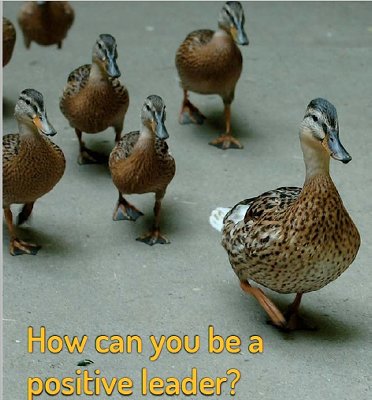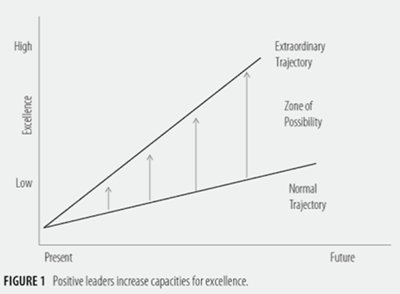 “How to Be a Positive Leader – Small Actions, Big Impact” by Jane Dutton and Gretchen Spreitzer offers a pragmatic overview of the developing field of Positive Organizational Scholarship. POS is developed by the Center for Positive Organizations of Ross School of Business (University of Michigan), founded by Kim Cameron and Robert Quinn. But this book includes chapters by other scholars as well, like Adam Grant. Let’s explore some of the small actions to become a leader with a positive impact, that are proven to yield a huge impact.
“How to Be a Positive Leader – Small Actions, Big Impact” by Jane Dutton and Gretchen Spreitzer offers a pragmatic overview of the developing field of Positive Organizational Scholarship. POS is developed by the Center for Positive Organizations of Ross School of Business (University of Michigan), founded by Kim Cameron and Robert Quinn. But this book includes chapters by other scholars as well, like Adam Grant. Let’s explore some of the small actions to become a leader with a positive impact, that are proven to yield a huge impact.
The issue with positive leadership is that it can sound corny and hippie to some. “Let’s all be happy bunnies at work.” If you look beyond that prejudice, you may judge that all the advice to be a positive leader is common sense. “Yeah, sure, give people attention and help them do their best at work.” But as you know: common sense is not common action.
As Shawn Achor (happiness and success author and researcher) says in the foreword: the book needs you to practice positive leadership and help create a more positive workplace. “This research is useless unless it is lived.” That is so true!
Invitation to be a positive leader
This is the invitation to you and me. What would happen if we all would DO these small actions? Together, we’d create positive change. Dutton and Spreitzer emphasize how small actions can have a huge impact and that they have experienced the power of seeing possibilities. They also stress that you don’t have to be a formal leader to use the positive leadership approach. Welcome to the new workplace where leadership is shared, and everyone takes responsibility.
Let’s do this
So: no excuses! Let’s do this and show others that positive change is possible. Achor: “If we want to change the way that organizations work, we need to learn deeply, embrace fully, and communicate this positive research effectively. Scientifically validated research and focused study of thriving leaders and organizations are the keys to opening minds to real and quantifiable positive change.”

This research is important because one huge impediment to change is that many people don’t believe that change is possible. You may recognize this as well: you started your work life optimistically, then you turned realistic and, finally, you may feel pessimistic or cynical. “Positive change? Welcome to this dog-eat-dog-workplace!”
I’m sorry if that’s where you find yourself. It is about time to get out of that workplace. Or it could be time to start changing your view, and practice small positive behaviors that will start to influence your organizational system.
Positive leaders can change what is “normal”. Instead of problem-solving and returning to the zero-line, they have an abundance mindset that stimulates “positive deviance”, looking for possibilities and building on what is already working well. The zero-line of normality could end further up the scale with positive leadership.
This is what companies such as Wells Fargo, Ford, Kelly Services, Burt’s Bees, Griffin Hospital, and Zingerman’s have been doing. They prove that you can create positive change in your organization through simple actions and attitude shifts.

Let’s explore some of the research and tips from the book.
High-quality connections
Jane Dutton explains that leaders need to encourage energizing interactions among their staff for a more creative organization and a competitive advantage.
Humans are social animals that thrive when they have high-quality connections: interactions where both participants’ energy levels are increased, for instance when you discuss a topic that matters to you.
Research shows that employees with many high-quality connections are more creative and motivated to learn new things, and that’s important for companies who aim for innovation.
There are two ways to encourage high-quality connections at work. Leaders need to demonstrate that they respect and value employees. They should pay attention to what they say and be positive when they voice their opinions. It helps to turn off your phone and move away from your computer to show that you’re fully present and listening.
It’s also crucial to facilitate teamwork and positive interactions by encouraging people to play more games. Team-building activities will do, as well as ping-pong tables, chessboards and basketball hoops in the workplace.
Check out an article about Jane Dutton’s research.
Cultivate hope
 Without hope, all is lost. Hope is a deep belief that both people and situations can change for the better. Oana Branzei does research on hope.
Without hope, all is lost. Hope is a deep belief that both people and situations can change for the better. Oana Branzei does research on hope.
Hope influences our emotions, thoughts, and actions. When you’re hopeful you feel more capable of reaching goals, and this enhances both confidence and action. Great leaders instilled hope: Nelson Mandela fought for human rights by raising hopes for a better future in others.
There are many ways to cultivate hope. One important step is to act as if your desired goals were feasible, no matter how unrealistic they seem. Taking that first step is crucial – if you never try, you’ll certainly never succeed.
Ray Anderson, the founder of Interface Inc. carpet company, declared he would eliminate any negative impact his company had on the environment. This seemed incredibly naive in 1994, but he took action as if the goal was achievable. By 2009, he was halfway there.
Hope is especially important when times are bad, so it must be cultivated. It’s one of the core tasks of leaders!
Micro-moves to change

Karen Golden-Biddle is researching change. Change is everywhere – so it’s about time that we learn to handle it better. Leaders often see employees as a source of change resistance, sometimes even expecting them to sabotage change. This viewpoint may induce what they fear: a top-down approach where employees feel ignored might lead to another failed change project.
The key is to not focus on the change-resistant people but on enticing the others to become resources for growth and change. That is positive leadership.
Micro-moves are small interactions and actions that can enhance sustainable change without disrupting the system and creating this infamous pushback while inviting people to collaborate and discover what to change. These micro-moves can create enthusiasm and momentum for change.
Leaders can stimulate a sense of ownership and freedom to experiment with employees. A positive leader can also help people understand the hidden benefits of change by asking possibility-oriented questions: “What skills will you build during this change?” and so on.
Further reading about a case in health care: https://hbr.org/2013/10/how-micro-moves-can-drive-major-health-care-change/

Cultivate positive identities
Laura Morgan Roberts emphasizes the importance of a positive identity. People do their best work when they feel good about themselves. That is “positive identity” and it helps you focus and perform better.
You feel good when four features are present, abbreviated as GIVE. You experience Growth: when you sense you are growing, by learning new skills and insights. It feels like becoming the person you’d like to be. You also experience Integration: the different roles of your life – in work life, family and hobbies – are aligned and fit together into a whole identity. Next, you cherish Virtuousness: you feel that you possess integrity and humility, and you act accordingly. Last but not least, you need Esteem: you want to feel appreciated by others.
Isn’t this a private matter to discuss with a personal coach? Not quite. Leaders can help employees enhance their positive identities by encouraging them to leverage strengths and virtues at work.
You can start with this “best-self” exercise: gather stories from friends and family about situations where they felt that you were at your best. Next, look to find common positive themes, and identify strengths that you can leverage at work.
Leaders and teams can do this exercise to find everyone’s best qualities and use them at work, in whatever setting. Further reading: https://www.theglobeandmail.com/report-on-business/careers/management/exploring-positive-identity-in-the-workplace/article1208655/?page=all

Ethical decisions
David Mayer shows that people appreciate ethical leaders. Mandela, Gandhi and Martin Luther King were ethical leaders who treated others in a respectful way and expected the same from their followers.
Ethical organizational leaders tend to have a positive impact on their staff. Studies show that employees who consider their leaders to be ethical are more satisfied with their jobs and perform better. Ethical leadership enhances people’s sense that their work is meaningful and “good.” People are very sensitive to what is fair, just and right.
Not surprisingly, employees with ethical leaders are far less likely to engage in unethical behavior like discrimination, and this further adds to a positive work environment.
The leader is important because others see them as role models whose good behavior they want to copy. There’s also human reciprocity at play: when employees are treated well by their leaders, they reciprocate by treating others well too.
Leaders should include ethical considerations in business discussions and act on them. What to do when you have a business opportunity that is not technically illegal, but raises ethical concerns? You could be tempted to bribe an international prospective client to win the assignment – because this is a normal custom in his culture, and your company badly needs this huge order…. The assignment would ensure the cash flow and jobs guaranteed for the next year. A great end that could justify the means. Or not?

It’s crucial to clarify your values and keep them in mind. If you’re facing a difficult decision, ask yourself this helpful question:
“Would I be comfortable if the consequences of my decision were published on the front page of the New York Times?”
If not, then it’s probably not in line with your values, and you should reconsider.
Ethical leadership means: doing the right thing. But this may be easier said than done. So many leaders feel the pressure of peers, their organizational culture, the burden of targets and responsibilities. It may be tempting to tell yourself that it is not so bad to make this one-time decision and soothe your conscience.

Ethical leadership has beneficial effects, both for yourself and for your organization.
Four tips by David Mayer: https://www.amanet.org/training/articles/How-to-Become-a-More-Ethical-Leader.aspx?pcode=XCRP&
Outsource inspiration
Adam Grant discusses how to “outsource inspiration”. People are motivated when they see the meaning of their work: how the organization contributes to the outside world. This inspiration from outside increases motivation.
In a study of student employees at a University of Michigan call center, the employees met a former student who had gotten his scholarship thanks to the funds raised by the call center. Suddenly, the fundraising seemed more meaningful, and the employees realized a substantial increase in revenue.
Other organizations can use this inspiration too, by connecting to their customers. Medtronic for instance, invites six patients each year whose lives have been transformed by the company’s medical technologies. This helps all employees to gauge the true impact of their work. At IBM, the top 50 senior executives visit at least five of the company’s biggest customers to see the impact of their work.
If direct contact is not possible, people can discuss where they felt they made positive impacts. At the investment bank Merrill Lynch teams start their weekly meetings by sharing stories about helping customers.
Read more here: https://hbr.org/2011/06/how-customers-can-rally-your-troops
Thrive at work

People who thrive have a sense of learning and vitality, as Gretchen Spreitzer and Christine Porath found in their research. Thriving employees report higher levels of job satisfaction, creativity, and courage. They feel more confident in their abilities to achieve anything. Thriving employees are not prone to burnout because they find their work energizing and engaging.
Organizations can help people thrive by providing a positive work environment. That means banning inappropriate, disrespectful and rude behavior. Danny Meyers, who owns 27 restaurants in New York City, insists on civility in the workplace. If a chef behaves disrespectfully, the chef needs to change, or he will be fired. This zero-tolerance policy ensures a positive work environment.
Next, people can be stimulated to acquire new knowledge and expertise. A study of high-tech workers showed that people who solicit new information – by asking for feedback – tend to be more energized and confident.
It is also important to get enough rest and exercise. Evidence shows that cardiovascular or strength training can improve your mood during the work day. In addition to exercise, people need at least seven to eight hours of sleep every night to stay positive.
Read more at: https://ns.umich.edu/new/releases/20165-being-happy-at-work-is-nice-but-thriving-is-betterand-more-productive
Job crafting
Job crafting is another positive leadership tool. Employees are happier and perform better when they can craft their job to fit their passions, values, and skills as shows Amy Wrzesniewski. The organization benefits from job-crafting as well: research shows that employees are less absent, perform significantly better and are more proactive.
People can craft their job according to their strengths, values, and interests. They can adjust tasks, relationships, and perceptions.
An executive who likes to help others reach their full potential might craft her job, so it includes coaching employees. An engineer who likes teaching could mentor juniors and a marketing manager who loves to write can start a company blog. An energetic receptionist could develop and guide the welcome-aboard-sessions for new hires, and so on.

Another way is to adjust your job to spend time with people you like, minimizing interaction with those you don’t. If you don’t get along with your boss, you can deliver high-quality job performance by reporting in emails instead of weekly meetings.
Check out: https://hbr.org/2010/06/managing-yourself-turn-the-job-you-have-into-the-job-you-want
What is your takeaway? What speaks to you most and why?
How can you practice this next week?
You can buy the book at: https://www.amazon.com/How-Be-Positive-Leader-Actions/dp/1626560285/
Marcella Bremer is an author and culture & change consultant. She co-founded this blog and ocai-online.com.
One Response
Fantastic post… Thank you for great tips!